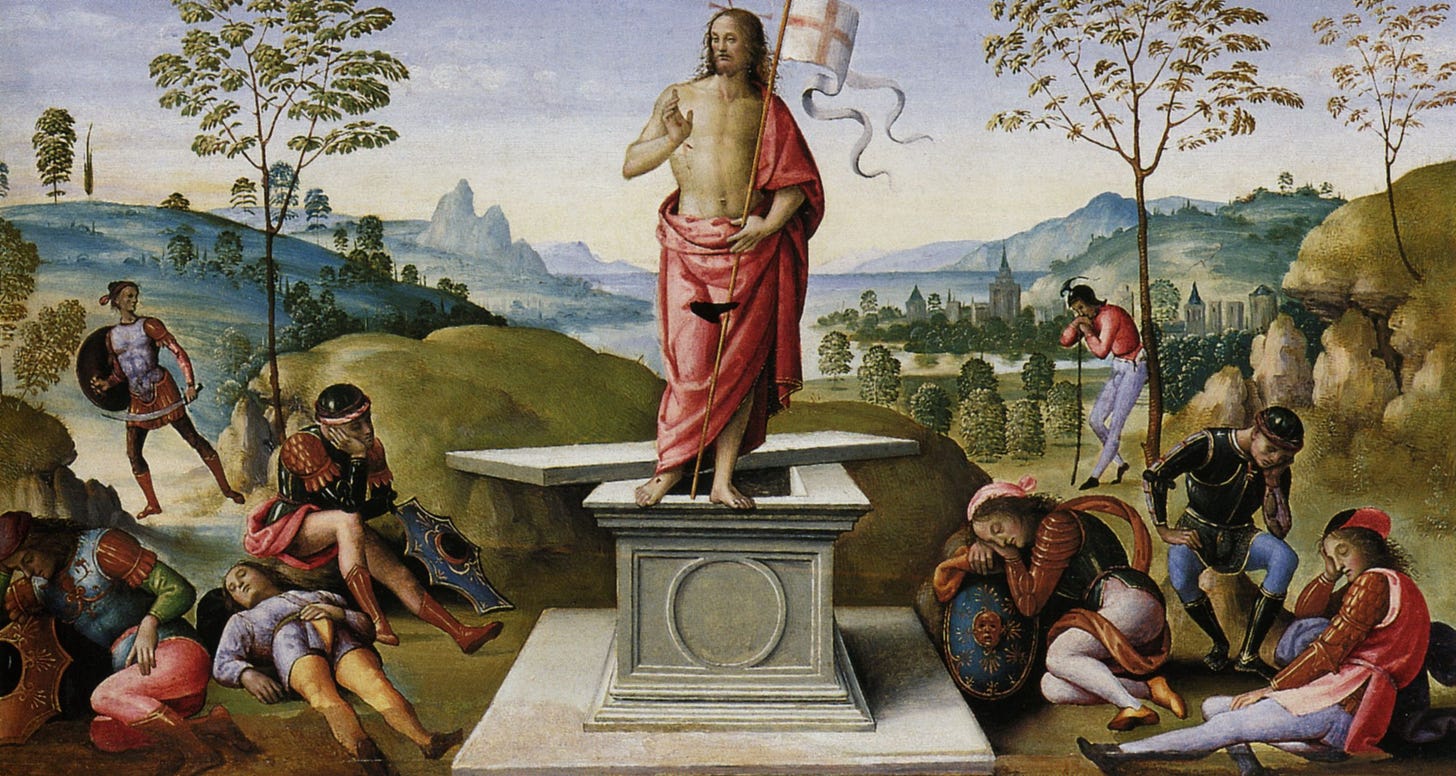Deacons don’t often get a chance to preach on Easter Sunday, and for good reason. The presider of the Mass is the normative homilist, and it is at his discretion that he may invite another priest or deacon to deliver the homily in his place. It’s quite understandable that most priests presiding over Masses of the Resurrection on Easter Sunday would not want to pass up the opportunity to preach on such an auspicious occasion.
Unless, of course, that priest is exhausted and could use a break! Like many small parishes, our pastor is the only priest, which means he stays quite busy. The liturgies of Holy Week, additional confession times, travel to the cathedral (three hours away in our case) for the Chrism Mass, and all the usual work involved in getting the parish ready for Easter can leave one feeling rather drained by Easter day. As the only active deacon currently at our parish, I want to help our pastor as best as I can, and one way I can do that is by offering to preach any homilies our priest wishes to give me for the Triduum. Often that means I’m preaching on Good Friday. But occasionally I’ve been asked to preach on Easter Sunday morning.
So here are my unsolicited thoughts on Easter preaching.
It’s all about the kerygma.
Kerygma is a Greek word meaning “proclamation,” and in the Christian context it refers specifically to the proclamation of the euangelium, the good news that Jesus Christ is the Savior of the world. An example of the kerygma proclaimed in scripture is St. Peter’s Pentecost proclamation recorded in the Acts of the Apostles (Acts 2:14-41). While the Christian faithful are always called to proclaim the gospel both in and out of season, to my mind, there is no better time for kerygmatic preaching than Easter morning, as we are (liturgically) gathered around the empty tomb so that we, like the Apostles, might “see and believe” (cf. Jn 20:8).
While I firmly believe there ought to be a kerygmatic element in every homily (when I’m composing a homily I always ask myself, “Where is the good news in what I’m preaching?”), Easter morning is a prime time to proclaim the gospel simply and straightforwardly.
I say this for a couple of reasons. First (and most obviously), Easter is the principle feast of the liturgical year, celebrating the passion, death, and resurrection of Jesus Christ, what we call the Paschal Mystery. This is it. This is the heart of our faith. This is when it is most important to restate and reaffirm what Christianity is all about.
The second reason is that the pews will be filled on Easter morning with people who need to hear the gospel preached to them. This is when the so-called “Christmas and Easter” (C&E) only Catholics come out, sometimes called “Creasters.” We joke at times that the Creasters displace the regulars from their pews, but the truth is we are happy to see them and wish we saw them more often! For this reason, the Christmas and Easter holidays are perfect times for evangelization. But it’s not the Creasters only that need to hear the gospel. We all do. I do. Every day. And I want to hear it especially on Easter.
So what does that look like? What is the heart of the kerygma and how do we proclaim it to the world today?
This podcast from Ascension Presents offers a simple four-part breakdown that helps us understand what the kerygmatic message entails.
4 Steps of the Kerygma:
God has a plan for your life.
Sin interrupts that plan and separates you from God.
Jesus Christ died and rose so that you could be forgiven of these sins and be united to God in heaven.
Through faith and his Church, you can be united to God forever.
This article on the USCCB website offers a similar breakdown; it also offers some advice on witnessing to others.
One key element is preaching to your audience. It’s not enough to proclaim the Good News of Jesus Christ. You need to help your listener see how Jesus is good news for them.
Peter understood this. In Acts, he proclaims the kerygma to a primarily Jewish audience, and so he speaks of Jesus in Messianic terms. He wants to show how Jesus is the fulfillment of the prophecies they knew and understood. That same tactic won’t work as well on a modern American audience (unless they happen to also be faithful Jewish believers).
In my experience, most non-believers today are practical atheistic materialists. Even if they don’t explicitly disbelieve in God, for all intents and purposes they live their lives as if God does not exist and this world is all they need to be concerned about.
I also find that many people suffer from a general spiritual malaise brought on by a lack of meaning and purpose, or a lack of any real sense of identity. This is not unrelated to having a materialist world view.
So in an Easter homily I was privileged to preach a few years ago, that’s where I started my proclamation of the kerygma.
What is the meaning of life? Why are we all here? I don’t just mean here in this church on Easter Sunday, but here in the world? The dominant secular culture today will tell you that you have to decide that for yourself; that you have to make your own meaning — which sounds nice; unless you take it seriously and start to think about it for any length of time, because to say we have to create our own meaning is the same as saying life doesn’t have any meaning at all.
I then go on to describe how this lack of meaning results from a materialist world view.
The idea that life means whatever we want it to mean stems from a materialist philosophy that denies the existence of any metaphysical, spiritual reality. In other words, the only real things are things we can see, touch, taste, hear and smell. Things we can measure. In this world view, we are all here because over the course of billions of years, random atoms and elements have come together and reacted with one another in such a way that you and I have come to be. Life arose because of a series of accidental chemical reactions. And when we die all these chemical processes will end and you and I will end. We will disappear into oblivion. The only “good news” of secular materialism is at least we won’t know we’re in oblivion because there won’t be any “us.” And this is no real loss anyway because there was never really any “us” to begin with. There is no such thing as a metaphysical person; what we call consciousness and personality are just illusions created by the physical processes in the brain. So yes, ascribe any meaning you want to your life, because it doesn’t really matter in the end.
Now comes the twist. I present them with an alternative.
That’s one story you can believe. But there is another.
I then lay out a basic case for finding order and purpose in the universe that is suggestive of an intelligent Creator, which leads into the kerygmatic proclamation of Christ.
The universe can’t create itself. It has a Creator. And that means you have a Creator. And that means you are intentional. You have a purpose. The good news of this world view is that you are wanted and loved. That also happens to be the good news proclaimed by Christ.
From there I proceed to go through the four basic steps of the kerygma as outlined above. God has a plan for us; sin messes up that plan; but through the death and resurrection of Christ we have a remedy for sin and through Christ’s Church we can find meaning, purpose, and union with God.
After proclaiming the kerygma, I conclude with this:
That’s also a story you can believe. It’s the best kind of story because it’s a true story, not written in a book but written in the pages of history. It’s a love story about you and me and God. In this story we discover the meaning of our life, which is to know, love and serve the God who made the universe. But even more than that, we discover the good news that God knows, loves, and serves us, too.
Then I offer an invitation to step out deeper in faith.
We can shut our eyes to that truth and refuse to see the beauty in front of us. Or, like John, we can gaze into the empty tomb with open eyes, and we can see and believe.
You can read or listen to the whole homily at the link below.
And by the way, though I’m filing this post under “diaconate,” the imperative to preach the gospel isn’t just for deacons, and it’s not just for priests (though those of us in holy orders do have a special charge to do so).
Mark’s gospel concludes with the command to “proclaim the gospel to every creature” (Mk 16:15). Those are marching orders for every Christian, as are the deacon’s final instructions to the faithful at Mass to, “Go and announce the Gospel of the Lord.” If we can’t announce the good news of the resurrection at Easter, when can we?
That Christ is risen is indeed good news. But do people perceive it as such? It is the job of believers to help non-believers see how the resurrection of Christ is good news for the world, and for them personally.
Now go and proclaim the gospel.





